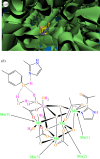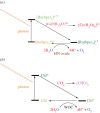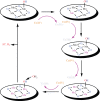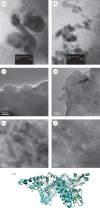Nano-sized manganese oxides as biomimetic catalysts for water oxidation in artificial photosynthesis: a review
- PMID: 22809849
- PMCID: PMC3427528
- DOI: 10.1098/rsif.2012.0412
Nano-sized manganese oxides as biomimetic catalysts for water oxidation in artificial photosynthesis: a review
Abstract
There has been a tremendous surge in research on the synthesis of various metal compounds aimed at simulating the water-oxidizing complex (WOC) of photosystem II (PSII). This is crucial because the water oxidation half reaction is overwhelmingly rate-limiting and needs high over-voltage (approx. 1 V), which results in low conversion efficiencies when working at current densities required for hydrogen production via water splitting. Particular attention has been given to the manganese compounds not only because manganese has been used by nature to oxidize water but also because manganese is cheap and environmentally friendly. The manganese-calcium cluster in PSII has a dimension of about approximately 0.5 nm. Thus, nano-sized manganese compounds might be good structural and functional models for the cluster. As in the nanometre-size of the synthetic models, most of the active sites are at the surface, these compounds could be more efficient catalysts than micrometre (or bigger) particles. In this paper, we focus on nano-sized manganese oxides as functional and structural models of the WOC of PSII for hydrogen production via water splitting and review nano-sized manganese oxides used in water oxidation by some research groups.
Figures








Similar articles
-
Water exchange in manganese-based water-oxidizing catalysts in photosynthetic systems: from the water-oxidizing complex in photosystem II to nano-sized manganese oxides.Biochim Biophys Acta. 2014 Sep;1837(9):1395-410. doi: 10.1016/j.bbabio.2014.03.008. Epub 2014 Mar 29. Biochim Biophys Acta. 2014. PMID: 24685431 Review.
-
Nano-sized layered Mn oxides as promising and biomimetic water oxidizing catalysts for water splitting in artificial photosynthetic systems.J Photochem Photobiol B. 2014 Apr 5;133:124-39. doi: 10.1016/j.jphotobiol.2014.03.005. Epub 2014 Mar 19. J Photochem Photobiol B. 2014. PMID: 24727405 Review.
-
A nano-sized manganese oxide in a protein matrix as a natural water-oxidizing site.Plant Physiol Biochem. 2014 Aug;81:3-15. doi: 10.1016/j.plaphy.2014.01.020. Epub 2014 Feb 6. Plant Physiol Biochem. 2014. PMID: 24560883 Review.
-
Comparison of nano-sized Mn oxides with the Mn cluster of photosystem II as catalysts for water oxidation.Biochim Biophys Acta. 2015 Feb;1847(2):294-306. doi: 10.1016/j.bbabio.2014.11.006. Epub 2014 Nov 25. Biochim Biophys Acta. 2015. PMID: 25461976 Review.
-
Nano-size amorphous calcium-manganese oxide as an efficient and biomimetic water oxidizing catalyst for artificial photosynthesis: back to manganese.Dalton Trans. 2011 Oct 7;40(37):9374-8. doi: 10.1039/c1dt11048a. Epub 2011 Aug 18. Dalton Trans. 2011. PMID: 21850343
Cited by
-
An approach for catalyst design in artificial photosynthetic systems: focus on nanosized inorganic cores within proteins.Photosynth Res. 2013 Nov;117(1-3):197-205. doi: 10.1007/s11120-012-9792-z. Epub 2013 Feb 3. Photosynth Res. 2013. PMID: 23377954 Review.
-
Thermodynamics of manganese oxides: Sodium, potassium, and calcium birnessite and cryptomelane.Proc Natl Acad Sci U S A. 2017 Feb 14;114(7):E1046-E1053. doi: 10.1073/pnas.1620427114. Epub 2017 Jan 27. Proc Natl Acad Sci U S A. 2017. PMID: 28130549 Free PMC article.
-
Nanostructured manganese oxide on silica aerogel: a new catalyst toward water oxidation.Photosynth Res. 2016 Dec;130(1-3):225-235. doi: 10.1007/s11120-016-0247-9. Epub 2016 Apr 1. Photosynth Res. 2016. PMID: 27037826
-
Gold or silver deposited on layered manganese oxide: a functional model for the water-oxidizing complex in photosystem II.Photosynth Res. 2013 Nov;117(1-3):423-9. doi: 10.1007/s11120-013-9899-x. Epub 2013 Jul 30. Photosynth Res. 2013. PMID: 23896796
-
Imidazolium or guanidinium/layered manganese (III, IV) oxide hybrid as a promising structural model for the water-oxidizing complex of Photosystem II for artificial photosynthetic systems.Photosynth Res. 2013 Nov;117(1-3):413-21. doi: 10.1007/s11120-013-9814-5. Epub 2013 Mar 31. Photosynth Res. 2013. PMID: 23543329
References
-
- Wydrzynski T., Hillier W. (eds) 2011. Molecular solar fuels. Cambridge, UK: Royal Society of Cambridge
-
- Najafpour M. M. (ed.) 2012. Artificial photosynthesis. Rijeka, Croatia: Tech Publications
-
- Pace R. J. 2005. An integrated artificial photosynthesis model. In Artificial photosynthesis from basic biology to industrial application (eds Collings A. F., Critchley C.), ch. 2 Weinheim, Germany: Wiley-VCH
-
- Reece S. Y., Hamel J. A., Sung K., Jarvil T. D., Esswein A. J., Pijpers J. J. H., Nocera D. G. 2011. Wireless solar water splitting using silicon-based semiconductors and earth-abundant catalysts. Science 334, 645–64810.1126/science.1209816 (doi:10.1126/science.1209816) - DOI - DOI - PubMed
-
- Lewis N. S. 2007. Toward cost-effective solar energy use. Science 315, 798–80110.1126/science.1137014 (doi:10.1126/science.1137014) - DOI - DOI - PubMed
Publication types
MeSH terms
Substances
LinkOut - more resources
Full Text Sources
Research Materials

